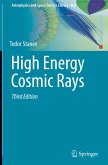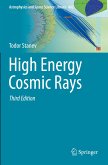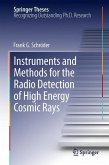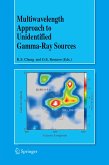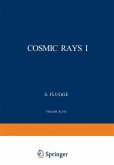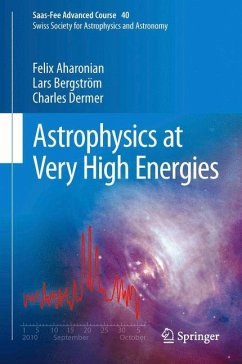Offers an accessible text and reference (a cosmic-ray manual) for graduate students entering the field and high-energy astrophysicists will find this an accessible cosmic-ray manual
Easy to read for the general astronomer, the first part describes the standard model of cosmic rays based on our understanding of modern particle physics.
Presents the acceleration scenario in some detail in supernovae explosions as well as in the passage of cosmic rays through the Galaxy.
Compares experimental data in the atmosphere as well as underground are compared with theoretical models
Cosmic rays are an essential part of the universe. Their origin is related to many important astrophysical processes, such as star formation, stellar evolution, supernova explosions and the state of interstellar matter in the Galaxy. Cosmic Ray Physics reviews our present knowledge of cosmic rays, describing how they are born in a wide range of cosmic processes, how they are accelerated and how they interact with matter, magnetic fields and radiation during their journey across the Galaxy. The book also describes the detection of cosmic rays, and the processes which take place, both at the top and within the Earth's atmosphere. The author also describes the very important area of the underground detection of very high energy cosmic rays and particles such as neutrinos.
The book is divided into two parts, the first describing the standard model of cosmic rays and contemporary challenges, and the second part dealing with very high energy cosmic rays that cannot be detected directly in satellite and balloon experiments, and with gamma-ray and neutrino astronomy. It is in this particular aspect of the book that the greatest developments have taken place during the 5 years since the first edition was completed. Consequently, it is in the chapters cosmic ray showers, their spectrum, on high energy neutrinos, and on gamma-ray astronomy of this revised and updated 2nd edition that a considerable amount of new material has been incorporated with more minor revisions and updating taking place in the first part of the book. Students and lecturers of advanced undergraduate courses on cosmic rays and astroparticle physics as well as post graduates and researchers will continue to find this book a valuable source of learning and reference.
Easy to read for the general astronomer, the first part describes the standard model of cosmic rays based on our understanding of modern particle physics.
Presents the acceleration scenario in some detail in supernovae explosions as well as in the passage of cosmic rays through the Galaxy.
Compares experimental data in the atmosphere as well as underground are compared with theoretical models
Cosmic rays are an essential part of the universe. Their origin is related to many important astrophysical processes, such as star formation, stellar evolution, supernova explosions and the state of interstellar matter in the Galaxy. Cosmic Ray Physics reviews our present knowledge of cosmic rays, describing how they are born in a wide range of cosmic processes, how they are accelerated and how they interact with matter, magnetic fields and radiation during their journey across the Galaxy. The book also describes the detection of cosmic rays, and the processes which take place, both at the top and within the Earth's atmosphere. The author also describes the very important area of the underground detection of very high energy cosmic rays and particles such as neutrinos.
The book is divided into two parts, the first describing the standard model of cosmic rays and contemporary challenges, and the second part dealing with very high energy cosmic rays that cannot be detected directly in satellite and balloon experiments, and with gamma-ray and neutrino astronomy. It is in this particular aspect of the book that the greatest developments have taken place during the 5 years since the first edition was completed. Consequently, it is in the chapters cosmic ray showers, their spectrum, on high energy neutrinos, and on gamma-ray astronomy of this revised and updated 2nd edition that a considerable amount of new material has been incorporated with more minor revisions and updating taking place in the first part of the book. Students and lecturers of advanced undergraduate courses on cosmic rays and astroparticle physics as well as post graduates and researchers will continue to find this book a valuable source of learning and reference.
From the reviews of the first edition:
"... carefully crafted and well-written." (Stefan Westerhoff, Columbia University, Physics Today, September 2004)
"This publication ... is aimed at serious students of the subject. ... Arranged in two parts, Stanev first describes the standard model of cosmic rays and the interactions that are important ... . The second part describes the challenges of current cosmic ray research ... . It is a 'must read' for those with a passion to find out more about the high energy universe." (Roger Feasey, Journal of the Auckland Astronomical Society AAS, August, 2005)
"Todor Stanev ... has distilled the essence of cosmic ray physics. It is a magnificent achievement and will be invaluable for workers in the field. It should also be available for consultation by researchers in related disciplines ... there will also be a need to make use of excellent list of referenced material." (Roger Clay, The Physicist, Vol. 41 (5), September/October, 2004)
"... carefully crafted and well-written." (Stefan Westerhoff, Columbia University, Physics Today, September 2004)
"This publication ... is aimed at serious students of the subject. ... Arranged in two parts, Stanev first describes the standard model of cosmic rays and the interactions that are important ... . The second part describes the challenges of current cosmic ray research ... . It is a 'must read' for those with a passion to find out more about the high energy universe." (Roger Feasey, Journal of the Auckland Astronomical Society AAS, August, 2005)
"Todor Stanev ... has distilled the essence of cosmic ray physics. It is a magnificent achievement and will be invaluable for workers in the field. It should also be available for consultation by researchers in related disciplines ... there will also be a need to make use of excellent list of referenced material." (Roger Clay, The Physicist, Vol. 41 (5), September/October, 2004)


